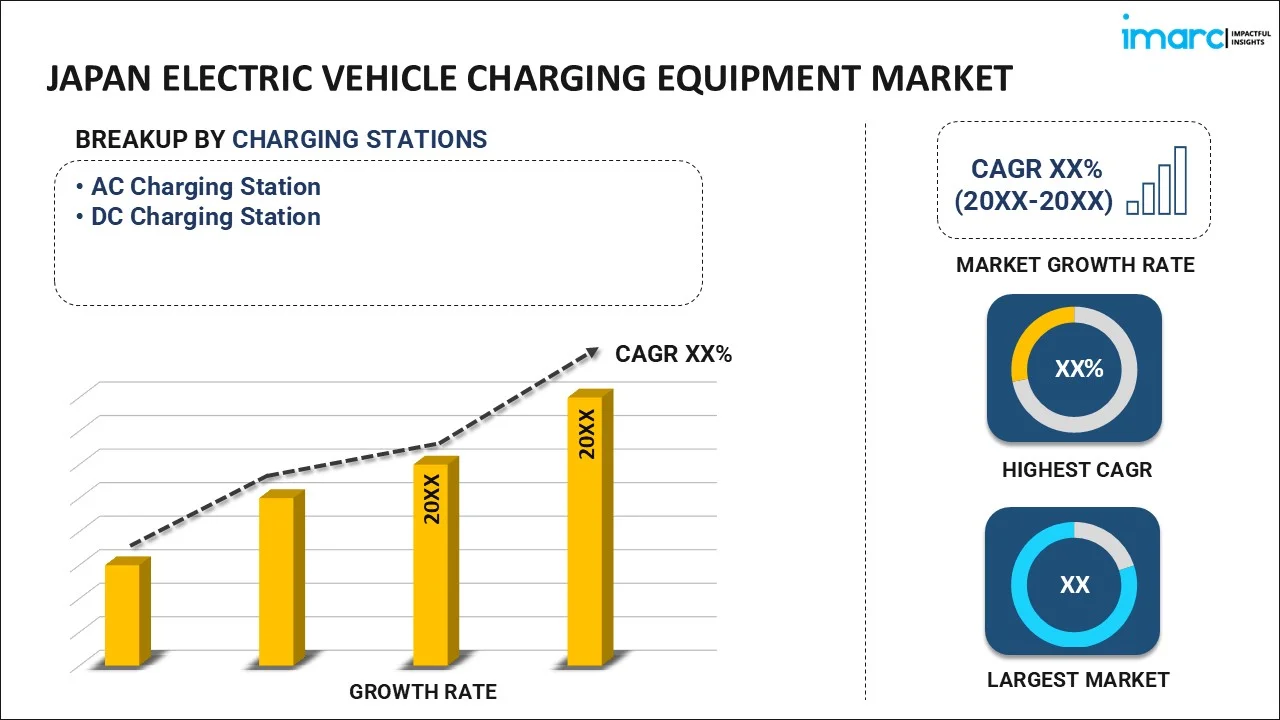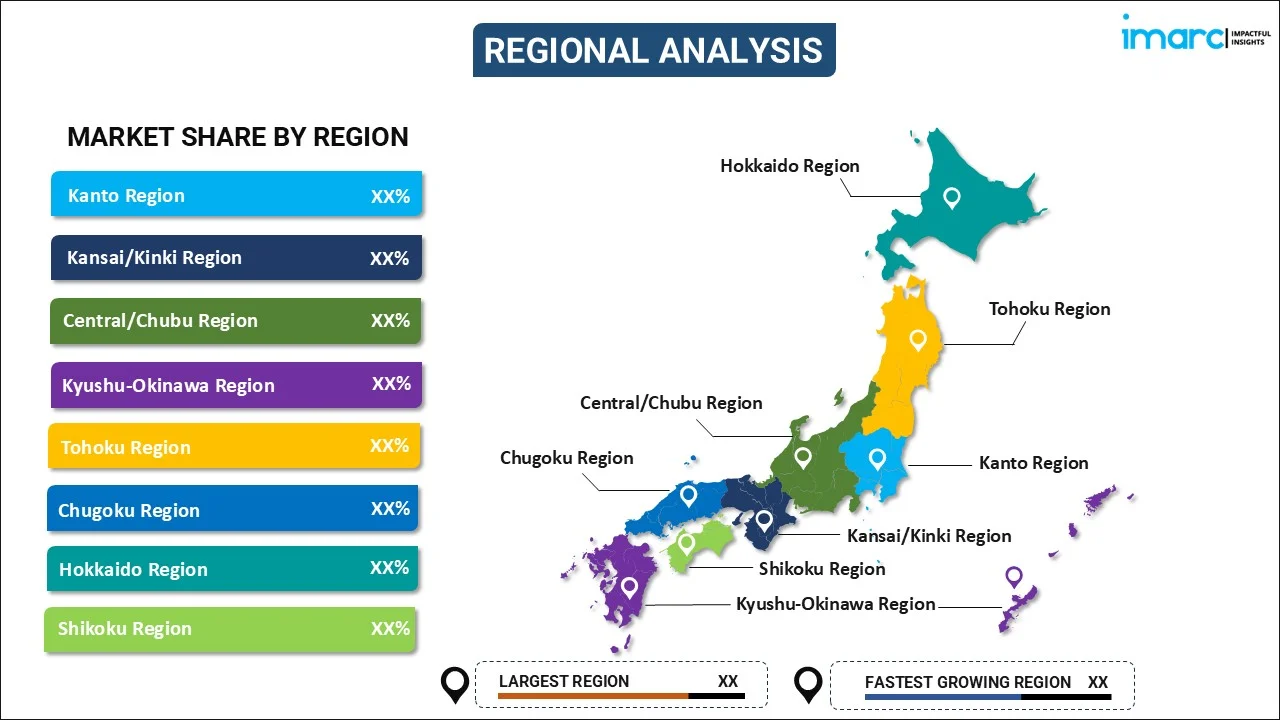
Japan Electric Vehicle Charging Equipment Market Size, Share, Trends and Forecast by Charging Station, End Use, and Region, 2025-2033
Japan Electric Vehicle Charging Equipment Market Overview:
The Japan electric vehicle charging equipment market size reached USD 1,441.10 Million in 2024. Looking forward, IMARC Group expects the market to reach USD 6,000.69 Million by 2033, exhibiting a growth rate (CAGR) of 17.17% during 2025-2033. The Japan electric vehicle charging equipment market share is growing due to the rising demand for electric vehicles (EVs), increasing focus on developing fast charging and battery swapping technologies to enhance fleet electrification, and higher investments by leading companies in charging solutions to meet sustainability targets.
|
Report Attribute
|
Key Statistics
|
|---|---|
|
Base Year
|
2024
|
|
Forecast Years
|
2025-2033
|
|
Historical Years
|
2019-2024
|
| Market Size in 2024 | USD 1,441.10 Million |
| Market Forecast in 2033 | USD 6,000.69 Million |
| Market Growth Rate 2025-2033 | 17.17% |
Japan Electric Vehicle Charging Equipment Market Trends:
Rising Demand for Electric Vehicles (EVs)
The growing inclination towards electric vehicles (EVs) in Japan, influenced by environmental consciousness and technological progress, is a key reason for the demand for EV charging stations. As more individuals switch to EVs, the demand for easy and accessible charging facilities becomes more essential. This demand is heightened by users' inclinations towards environmentally friendly, low-emission options instead of conventional cars. Japan's major automobile manufacturers are pouring resources into electric vehicles, propelling the EV market ahead. As more electric vehicle models debut, a growing network of charging stations is essential to bolster the infrastructure for these cars, promoting better user experiences and fostering EV adoption nationwide. For example, in 2025, Hyundai revealed the introduction of its least expensive electric vehicle in Japan, the Hyundai Inster. This action intends to penetrate Japan's competitive market, which is led by domestic manufacturers such as Toyota and Honda.
Introduction of Fast Charging Solutions for Fleet Electrification
The progress in rapid charging and battery exchange technologies is crucial in facilitating the adoption of electric vehicles, particularly for commercial fleets. Innovations like battery swapping stations that provide quick recharging options are tackling one of the major obstacles to electric vehicle growth, which is the duration of charging. By being able to change a battery within minutes, fleet managers can reduce downtime, allowing their vehicles to remain operational for extended periods and enhancing efficiency. This technology is especially advantageous for industries dependent on high-utilization vehicles, like taxis and delivery services, where rapid turnaround times are essential. With the increasing demand for environmentally friendly, low-emission transport options, the implementation of cutting-edge charging technologies for fleets aids in larger decarbonization initiatives, enabling companies to achieve sustainability goals and enhancing the overall development of EV infrastructure. In 2024, Japan introduced its initial battery swapping stations in Kyoto, created by Ample in partnership with ENEOS. The stations included two drive-through pods that enable a complete charge in only 5 minutes and assist local fleets such as MK Taxi. This effort was designed to boost EV uptake and support Japan’s decarbonization objectives.
Corporate Sustainability Goals and Green Marketing
Corporate sustainability objectives are driving prominent companies in Japan to quickly boost their funding in EV charging facilities. Numerous businesses are coordinating their activities with Japan’s environmental objectives, such as achieving carbon neutrality by 2050. Companies are utilizing eco-friendly marketing approaches to appeal to environmentally aware consumers. Consequently, businesses in sectors like retail, hospitality, and transportation are setting up EV charging stations at their locations to showcase their dedication to sustainability. The increasing trend of companies providing EV charging within their sustainability efforts is creating a demand for additional charging stations. In December 2023, All Nippon Airways (ANA) set up ABB’s Terra CE 54 CJG rapid charger at Tokyo Haneda Airport for its electric Ground Support Equipment (GSE) vehicles. The charger supported various charging standards, such as CHAdeMO, AC, and DC CCS 2. This project backed ANA's sustainability objectives and carbon-neutral initiatives in airport operations.
Japan Electric Vehicle Charging Equipment Market Segmentation:
IMARC Group provides an analysis of the key trends in each segment of the market, along with forecasts at the regional level for 2025-2033. Our report has categorized the market based on charging station and end use.
Charging Station Insights:

- AC Charging Station
- DC Charging Station
The report has provided a detailed breakup and analysis of the market based on the charging station. This includes AC charging station and DC charging station.
End Use Insights:
- Home Charging
- Public Charging
A detailed breakup and analysis of the market based on the end use have also been provided in the report. This includes home charging and public charging.
Regional Insights:

- Kanto Region
- Kansai/Kinki Region
- Central/ Chubu Region
- Kyushu-Okinawa Region
- Tohoku Region
- Chugoku Region
- Hokkaido Region
- Shikoku Region
The report has also provided a comprehensive analysis of all the major regional markets, which include Kanto Region, Kansai/Kinki Region, Central/ Chubu Region, Kyushu-Okinawa Region, Tohoku Region, Chugoku Region, Hokkaido Region, and Shikoku Region.
Competitive Landscape:
The market research report has also provided a comprehensive analysis of the competitive landscape. Competitive analysis such as market structure, key player positioning, top winning strategies, competitive dashboard, and company evaluation quadrant has been covered in the report. Also, detailed profiles of all major companies have been provided.
Japan Electric Vehicle Charging Equipment Market News:
- In October 2024, PowerX revealed a collaboration with Mercedes-Benz to create an EV charging infrastructure in Japan. PowerX intends to produce Hypercharger units and oversee the deployment of charging stations, with a goal of setting up 100 charging ports at 25 sites in key cities within the next two years.
- In April 2024, Audi unveiled its inaugural charging hub outside of Europe in Tokyo, featuring four fast-charging stations with a capacity of up to 150 kW. Situated in the Kioichō business area, it accommodated EVs from various brands and utilized renewable energy, incorporating a battery storage system to reduce grid demands. Audi intended to establish a second hub in the Shiba kōen area of Tokyo.
Japan Electric Vehicle Charging Equipment Market Report Coverage:
| Report Features | Details |
|---|---|
| Base Year of the Analysis | 2024 |
| Historical Period | 2019-2024 |
| Forecast Period | 2025-2033 |
| Units | Million USD |
| Scope of the Report |
Exploration of Historical Trends and Market Outlook, Industry Catalysts and Challenges, Segment-Wise Historical and Future Market Assessment:
|
| Charging Stations Covered | AC Charging Station, DC Charging Station |
| End Uses Covered | Home Charging, Public Charging. |
| Regions Covered | Kanto Region, Kansai/Kinki Region, Central/ Chubu Region, Kyushu-Okinawa Region, Tohoku Region, Chugoku Region, Hokkaido Region, Shikoku Region. |
| Customization Scope | 10% Free Customization |
| Post-Sale Analyst Support | 10-12 Weeks |
| Delivery Format | PDF and Excel through Email (We can also provide the editable version of the report in PPT/Word format on special request) |
Key Questions Answered in This Report:
- How has the Japan electric vehicle charging equipment market performed so far and how will it perform in the coming years?
- What is the breakup of the Japan electric vehicle charging equipment market on the basis of charging station?
- What is the breakup of the Japan electric vehicle charging equipment market on the basis of end use?
- What is the breakup of the Japan electric vehicle charging equipment market on the basis of region?
- What are the various stages in the value chain of the Japan electric vehicle charging equipment market?
- What are the key driving factors and challenges in the Japan electric vehicle charging equipment market?
- What is the structure of the Japan electric vehicle charging equipment market and who are the key players?
- What is the degree of competition in the Japan electric vehicle charging equipment market?
Key Benefits for Stakeholders:
- IMARC’s industry report offers a comprehensive quantitative analysis of various market segments, historical and current market trends, market forecasts, and dynamics of the Japan electric vehicle charging equipment market from 2019-2033.
- The research report provides the latest information on the market drivers, challenges, and opportunities in the Japan electric vehicle charging equipment market.
- Porter's five forces analysis assist stakeholders in assessing the impact of new entrants, competitive rivalry, supplier power, buyer power, and the threat of substitution. It helps stakeholders to analyze the level of competition within the Japan electric vehicle charging equipment industry and its attractiveness.
- Competitive landscape allows stakeholders to understand their competitive environment and provides an insight into the current positions of key players in the market.
Need more help?
- Speak to our experienced analysts for insights on the current market scenarios.
- Include additional segments and countries to customize the report as per your requirement.
- Gain an unparalleled competitive advantage in your domain by understanding how to utilize the report and positively impacting your operations and revenue.
- For further assistance, please connect with our analysts.
 Inquire Before Buying
Inquire Before Buying
 Speak to an Analyst
Speak to an Analyst
 Request Brochure
Request Brochure
 Request Customization
Request Customization




.webp)




.webp)












